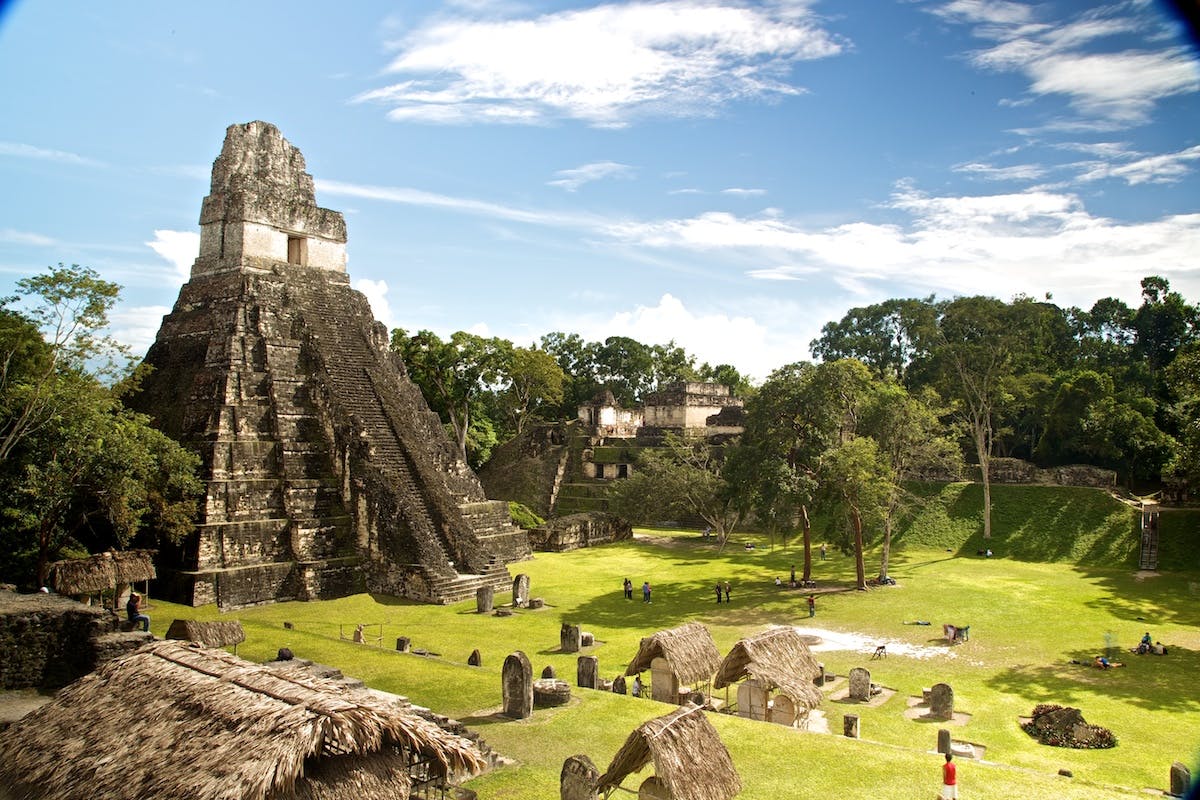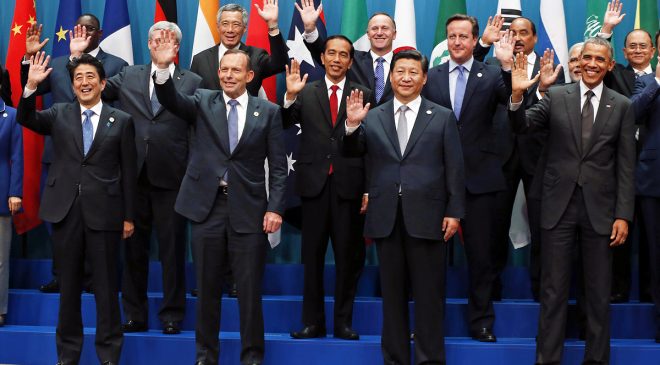I first journeyed to Guatemala 20 years ago, hosted by Universidad Francisco Marroquín. Two weeks ago, I returned for a delightful extended visit, accompanied by my Spanish-speaking elder sons and former EconLog blogger Jim Schneider. I spent over a week doing guest lectures at UFM, then gave Friday’s keynote talk for the Reason Foundation’s “Reason in Guatemala” conference. During our trip, we were also able to visit the awesome Mayan ruins of Tikal and Yaxha. Here are my reflections on the experience.
1. Guatemala has dramatically improved over the last two decades. Multinational businesses are now all over Guatemala City. Restaurants and luxury products are all over, but so are businesses that cater to average Guatemalans. Local grocery stores are packed with familiar international brands and products. There are multiple Walmarts. Even Costco is there, doing business as Pricesmart. We argued about whether the Oakland Mall was more impressive than Tyson’s I, but it was definitely a tough call. Smartphones are naturally ubiquitous. Whenever we strayed from the tourist areas, we saw ordinary citizens enjoying simple material pleasures like Pollo Campero.
2. When I last visited Guatemala, the high-end businesses seemed grossly overbuilt; the shiny malls were almost empty. Now, however, Guatemalans actually seem to be consuming the fruits of progress. The cavernous Oakland Mall was packed at lunchtime on a weekday – and the pedestrianized streets near the National Palace were full of locals. La Aurora Zoo was world-class, but we saw no other foreign tourists.
3. Our sponsors at UFM strove to keep us perfectly safe. For the first few days, they drove us everywhere. Yet almost every local assured us that four guys walking around Zone 10 in broad daylight were extremely safe. By the end, we were walking comfortably through a wide range of neighborhoods, though only by day. Crime is clearly down, thanks in no small part to massive private security. Even small stores often have heavily-armed guards, and razor wire is almost always in your field of vision.
5. The greatest danger to pedestrians is probably the poor sidewalks; there are many dangerous pits even in elite neighborhoods. The problem is so dire and the cost of fixing it is so small that I’m surprised that local businesses haven’t raised money to solve it. I know Latin America’s philanthropic tradition is weak. Yet good publicity aside, wouldn’t the Oakland Mall soon recoup a $50-100k investment in the surrounding sidewalks? Would local government really block this public-spirited initiative?
6. We didn’t have to walk far to see absolute poverty. No one looked malnourished, and even kids living in shacks and huts usually wore new, store-bought clothes. Still, we saw families living in shacks (in Guatemala City, especially near the airport) and huts (especially on the drive to Yaxha). During one severe traffic jam, we saw kids under ten washing car windows. We also witnessed several families of clowns busking in the streets.
7. By official measures, Guatemala is dramatically poorer than any of the Caribbean islands we recently toured, with per capita GDP of $3200 nominal and $7600 PPP. Yet this is mightily difficult to reconcile with what we saw with our own eyes. Overall, the Caribbean islands looked a lot like the road from Flores to Yaxha – a mixture of modest modern houses and primitive shacks and huts. Everything else in Guatemala looked vastly better than St. Maarten or St. Kitts. While this partly reflects higher population, the biggest contrast is that almost every Guatemalan looks like he has useful work to do. The Caribbean islanders, in contrast, have high levels of desperate peddling and outright idleness.
8. Guatemalan prices confused not only us, but local economists as well. Grocery prices are very high. Guatemala’s Pricesmart and my local Costco sell many identical goods, so I can confidently say that the former’s prices were roughly twice as high as I normally pay. Local chains were even pricier. One prominent local businessman blamed Guatemala’s low port capacity – and impishly shared his thrilling plans to build a big new port in the near future. Restaurant meals aren’t cheap either; everything from fast food to premium steaks costs about the same as it would in Virginia. The only product that was blatantly cheaper than usual was Uber – about one-third of the U.S. rate. (Since gas prices were a bit higher than in Virginia, drivers’ take-home pay must be low indeed). Other services, such as tour guides, were also big bargains.
9. As I toured Guatemala, I couldn’t help but notice how happy the people looked, especially the women. I wondered if my impression could just be confirmation bias, but now that I’m back home I’m confident that the contrast is stark. Guatemalan men look at least marginally happier than American men. Guatemalan women look much happier than American women. You could say that this merely reflects cultural differences in expressiveness, but that strikes me as sheer stubborn denial.
10. UFM was the jewel of our visit. UFM could well be the most beautiful of the hundred-odd universities I’ve toured in my life. Built in a ravine, it elegantly blends distinctive architecture with gorgeous tropical flora. UFM also hosts two stunning museums – Popol Vuh (archaeology) and Ixchel (textiles). Best of all, UFM is an academic libertarian paradise. The ideas and imagery of my intellectual heroes adorn the whole campus – Milton Friedman, Ayn Rand, and Ludwig von Mises are only the beginning. Yet there is no sign of dogmatic orthodoxy. Good manners prevail; faculty and students are eager to hear new ideas and debate old ones. Unlike most other institutions, UFM administrators are especially intellectually engaged. UFM President Gabriel Calzada Alvarez was overjoyed to talk ideas with my sons for hours.
11. The students of UFM look even happier than the rest of their countrymen. You could say this is because they’re drawn from Guatemala’s richest families, but so are Americans in the Ivy League – and those kids are hardly pictures of good cheer. The gender gap was so big that I wouldn’t have believed it if I hadn’t seen it with my own ideas; female UFM students appear extraordinarily happy. UFM econ’s male/female ratio is also strangely low; several of the classes I taught were virtually all-female.
12. My Guatemalan audiences took to Open Borders like fish to water. The cultural and political threat of Muslim immigration was the sole recurring objection. In Guatemalan eyes, Latin America and the U.S. share a common Judeo-Christian culture, so many were surprised to hear how many U.S. citizens view Latin Americans as culturally alien or even unassimilable.
13. On the latter issue, the Guatemalans are plainly correct. Pre-assimilation to the North American way of life is prevalent and intense. Virtually everyone at UFM speaks and understands English well. About a fifth of the public signs in Guatemala City are entirely in English, and an additional third are in Spanglish. The Guatemalan elite already lives the American dream, más o menos. The average Guatemalan struggles to do the same. A dozen different people emphatically described Guatemalans as “deeply conservative,” but Tarantino was on t.v. every time I flipped the channels.
14. Even Guatemalan libertarians rarely complained about specific domestic government policies, but if you look at their Economic Freedom of the World ranking, there is plenty to decry. Guatemala gets great scores on Size on Government and Sound Money, and a good score on Freedom to Trade Internationally. Yet it gets an awful score for Legal System & Property Rights, and an even worse score for Regulation. New construction projects are all over Guatemala City, but one of the locals told me it takes 2-3 years to obtain permission to build. Imagine how much construction there’d be if you cut the delay down to 2-3 months or 2-3 weeks!
15. So what do Guatemalans complain about? I asked one of my classes to tell me what most bothered the average Guatemalan; then I proposed workable policy responses for each problem. Their first answer was “corruption.” I suggested hiring a team of Swiss or Singaporeans to take over Guatemala’s internal affairs department. They saw the logic of importing trustworthiness, but told me that Guatemalans wouldn’t accept it. Their next answer was “traffic.” I proposed electronic road pricing. They again saw the logic, and again told me that Guatemalans wouldn’t accept it – even if the gas tax were abolished at the same time. My students also saw crime – especially kidnapping – as a grave problem. They were almost dumbstruck when I suggested a big switch from incarceration to flogging, even though Guatemala’s indigenous peoples already heavily rely on corporal punishment. In a poor country with heavy corruption and high crime, the case for flogging is mighty indeed. Just ask criminal-justice reformer Jason Brennan!
16. If I had to move to another country, Guatemala would be high on my list. First and foremost, I love the UFM community. American liberalism and conservatism are intellectual dead-ends, and I would enjoy forever escaping from both. I also prefer to be around very happy people, and on that score Guatemala handily beats the U.S.A. Guatemala does have some scary features, but the longer I stayed, the more I relaxed. Yet for now, I continue to prefer the U.S. Wages are obviously much higher here, and PPP measures notwithstanding, a dollar goes further in the U.S. than in Guatemala.
17. The Mayan archaeological sites we visited deserve all the hyperbolic adjectives people apply to them. The contrast between the pyramids and the palaces, however, is vast. The pyramids you leave thinking, “Human beings made these?! Without wheels?!” (As well as, “They performed human sacrifices here?! What the hell was wrong with these Mayans?!”) The “palaces” of the Mayan leaders, in contrast, look smaller than many apartments in Fairfax. To reverse Galbraith, the Mayan elite lived lives of public affluence and private squalor.




